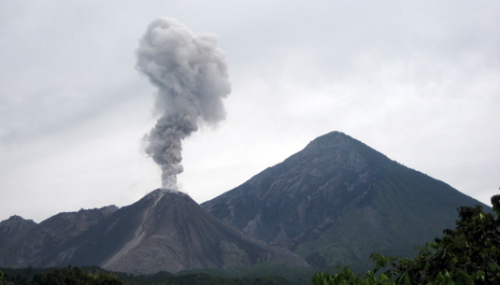Volcanic ash can threaten air traffic

The presence of volcanic ash in the upper atmosphere presents multiple threats to aviation. It not only reduces visibility and abrades the exposed areas of the aircraft, the fine particles can also endanger the operation of aircraft engines. Recent experiments undertaken by volcanologists, led by Professor Donald Dingwell, Director of the Department of Earth and Environmental Science at LMU Munich, have shown that reheated ash becomes molten and begins to flow at temperatures around 1050°C. The resulting viscous droplets can adhere to surfaces, and could thus damage jet-engine turbines more severely than is generally assumed. The new work is described in two papers that appear in the Journal of Applied Volcanology and Geophysical Research Letters.
The studies were carried out on ash samples obtained from two sources: Eyjafjallajökull volcano, in Iceland, and Santiaguito, in Guatemala. With the aid of a special microscope equipped with a heating stage, the researchers observed the change in morphology of ash pellets when subjected to a stepwise increase in temperature over the range 50 to 1600°C. This range encompasses the prevailing temperatures in the different parts of the turbines used in jet engines.
"At high temperatures, volcanic ash particles behave like sticky droplets of grease, which could potentially coat vital components of the engines," says Dr. Wenjia Song. This could lead to alterations in the airflow within the turbines and compromise the cooling of the engines.
The ash particles used in the experiments began to soften at around 600 degrees, and fused to form porous agglomerates at 1050°C. "Our studies show that volcanic ash melts and can stick to surfaces at lower temperatures than anticipated. This means that they are potentially more hazardous to air traffic than currently believed," says Dr. Ulrich Kueppers.
The researchers compared this behavior to that of the quartz sand conventionally used by engine manufacturers to test the durability of turbines. This material turned out to behave differently in the same range of temperature than the ash particles. "Crystalline sand is not an appropriate material with which to simulate the effects of volcanic ash on aircraft engines," Kueppers concludes. For this reason, the authors of the new studies argue that the threat to jet-engine turbines posed by volcanic ash needs further assessment. "Moreover, such tests should evaluate the effects of varying ash particle concentrations both by weight and by number," says Kueppers.
More information: Song, W., K.-U. Hess, D. E. Damby, F. B. Wadsworth, Y. Lavallée, C. Cimarelli, and D. B. Dingwell (2014), Fusion characteristics of volcanic ash relevant to aviation hazards, Geophys. Res. Lett., 41, 2326–2333, DOI: 10.1002/2013GL059182.
The thermal stability of Eyjafjallajökull ash versus turbine ingestion test sands. Ulrich Kueppers, et al. Journal of Applied Volcanology 2014, 3:4 DOI: 10.1186/2191-5040-3-4
Journal information: Geophysical Research Letters
Provided by Ludwig Maximilian University of Munich
















